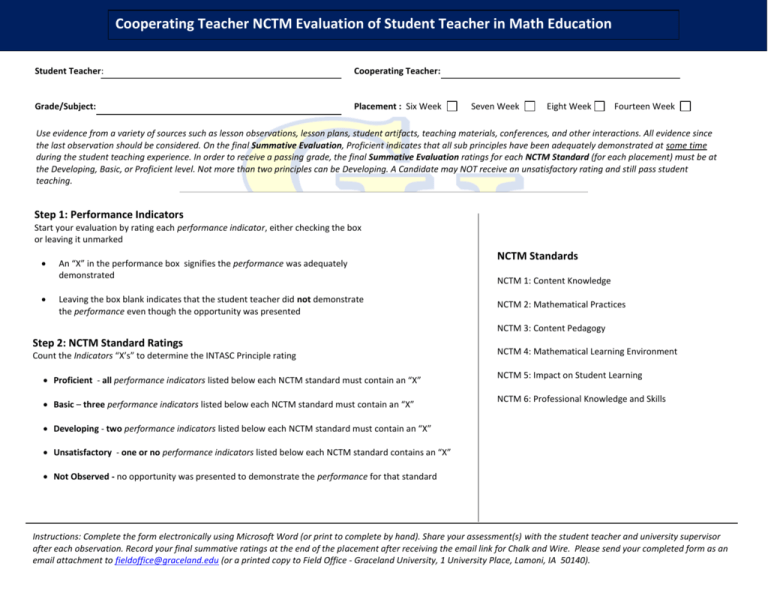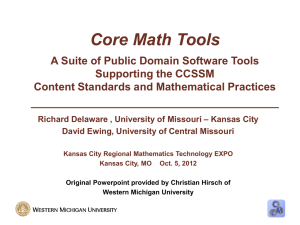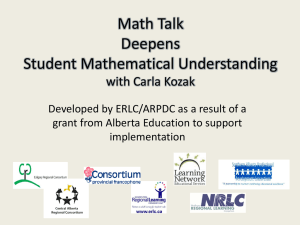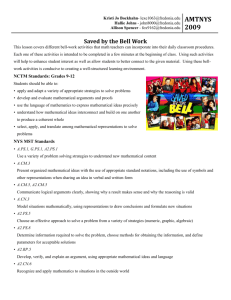(NCTM - Math) Coop - My Graceland Home
advertisement

Cooperating Teacher NCTM Evaluation of Student Teacher in Math Education Student Teacher: Cooperating Teacher: Grade/Subject: Placement : Six Week Seven Week Eight Week Fourteen Week Use evidence from a variety of sources such as lesson observations, lesson plans, student artifacts, teaching materials, conferences, and other interactions. All evidence since the last observation should be considered. On the final Summative Evaluation, Proficient indicates that all sub principles have been adequately demonstrated at some time during the student teaching experience. In order to receive a passing grade, the final Summative Evaluation ratings for each NCTM Standard (for each placement) must be at the Developing, Basic, or Proficient level. Not more than two principles can be Developing. A Candidate may NOT receive an unsatisfactory rating and still pass student teaching. Step 1: Performance Indicators Start your evaluation by rating each performance indicator, either checking the box or leaving it unmarked An “X” in the performance box signifies the performance was adequately demonstrated Leaving the box blank indicates that the student teacher did not demonstrate the performance even though the opportunity was presented Draw a line through the box if there was NO opportunity to observe the subStep 2: NCTM Standard Ratings principle Count the Indicators “X’s” to determine the INTASC Principle rating NCTM Standards NCTM 1: Content Knowledge NCTM 2: Mathematical Practices NCTM 3: Content Pedagogy NCTM 4: Mathematical Learning Environment Proficient - all performance indicators listed below each NCTM standard must contain an “X” NCTM 5: Impact on Student Learning Basic – three performance indicators listed below each NCTM standard must contain an “X” NCTM 6: Professional Knowledge and Skills Developing - two performance indicators listed below each NCTM standard must contain an “X” Unsatisfactory - one or no performance indicators listed below each NCTM standard contains an “X” Not Observed - no opportunity was presented to demonstrate the performance for that standard Instructions: Complete the form electronically using Microsoft Word (or print to complete by hand). Share your assessment(s) with the student teacher and university supervisor P a g e | 1 7/14/2015 after each observation. Record your final summative ratings at the end of the placement after receiving the email link for Chalk and Wire. Please send your completed form as an email attachment to fieldoffice@graceland.edu (or a printed copy to Field Office - Graceland University, 1 University Place, Lamoni, IA 50140). 4 - 6 Weeks Date: NCTM Math Standards Performance Indicators Summative (Culmination of previous evals) Date: Proficient Proficient Proficient Basic Basic Basic Developing Developing Developing Unsatisfactory Unsatisfactory Unsatisfactory Not Observed Not Observed Not Observed NCTM 1: Content Knowledge Effective teacher candidates demonstrate and apply knowledge of major mathematics concepts, algorithms, procedures, connections, and applications within and among mathematical content domains 10 Weeks Date: K12 Teaching Standard: 2; Conceptual Framework: Leads; CAEP Standard: .11; InTASC: 4 The candidate demonstrates and applies solid knowledge of mathematical content areas. (Number, Algebra, Geometry, Trigonometry, Statistics, Probability, Calculus, Evidence: and Discrete Mathematics) Evidence: Evidence: Evidence: Evidence: Evidence: Evidence: Evidence: Evidence: Evidence: Evidence: Evidence: The candidate demonstrates and applies knowledge of mathematic procedures. The candidate demonstrates and applies knowledge of mathematic applications. The candidate demonstrates and applies knowledge of mathematic connections. P a g e |2 7/14/2015 Proficient Proficient Proficient Basic Basic Basic Developing Developing Developing Unsatisfactory Unsatisfactory Unsatisfactory Not Observed Not Observed Not Observed NCTM 2: Mathematical Practices Effective teacher candidates solve problems, represent mathematical ideas, reason, prove, use mathematical models, attend to precision, identify elements of structure, generalize, engage in mathematical communication, and make connections as essential mathematical practices. They understand that these practices intersect with mathematical content and that understanding relies on the ability to demonstrate these practices within and among mathematical domains and in their teaching Performance Indicators K12 Teaching Standard:3; Conceptual Framework: Reflects; CAEP Standard: 1.1; InTASC: 7 The candidate creates learning experiences that include problem solving for a wide variety of problems and use of a wide variety of strategies to solve problems Evidence: confronted within the field of mathematics and other contexts. Learning experiences include formulating and testing conjectures in order to frame generalizations. Evidence: Evidence: The candidate creates learning experiences to engage students in formulating, representing, analyzing, and interpreting mathematical models derived from real- Evidence: world contexts or mathematical problems. Evidence: Evidence: The candidate creates learning experiences to engage students in organizing mathematical thinking and using the language of mathematics to express ideas precisely, both orally and in writing to multiple audiences. Evidence: Evidence: Evidence: The candidate creates learning experiences that enable learners to make connections between mathematical ideas and how they build on one another and Evidence: to recognize and apply mathematical connections among mathematical ideas and across various content areas and real-world contexts. Evidence: Evidence: P a g e |3 7/14/2015 Proficient Proficient Proficient Basic Basic Basic Developing Developing Developing Unsatisfactory Unsatisfactory Unsatisfactory Not Observed Not Observed Not Observed NCTM 3: Content Pedagogy Effective teacher candidates apply knowledge of curriculum standards for mathematics and their relationship to student learning within and across mathematical domains. They incorporate research-based mathematical experiences and include multiple instructional strategies and mathematics-specific technological tools in their teaching to develop all students’ mathematical understanding and proficiency. They provide students with opportunities to do mathematics – talking about it and connecting it to both theoretical and realworld contexts. They plan, select, implement, interpret, and use formative and summative assessments for monitoring student learning, measuring student mathematical understanding, and informing practice. Performance Indicators K12 Teaching Standard:3; Conceptual Framework: Leads; CAEP Standard: 1.1; InTASC: 6 The candidate implements learning experiences that incorporate curriculum standards for secondary mathematics within and across mathematical domains Evidence: Evidence: Evidence: The candidate plans lessons and units that incorporate a variety of strategies, differentiated instruction for diverse populations, and mathematics-specific and instructional technologies to build all students’ conceptual understanding and procedural proficiency. Evidence: Evidence: Evidence: The candidate engages students in high quality tasks, mathematical discussions, responding to key mathematical ideas, examination of misconceptions, and response to a range of questioning strategies. Evidence: Evidence: Evidence: The candidate provides evidence of planning, selecting, implementing, interpreting, and using formative and summative assessments to inform instruction by reflecting on mathematical proficiencies essential for all students. Evidence: Evidence: Evidence: P a g e |4 7/14/2015 Proficient Proficient Proficient Basic Basic Basic Developing Developing Developing Unsatisfactory Unsatisfactory Unsatisfactory Not Observed Not Observed Not Observed NCTM 4: Mathematical Learning Environment Effective teachers of secondary mathematics exhibit knowledge of adolescent learning, development, and behavior. They use this knowledge to plan and create sequential learning opportunities grounded in mathematics education research where students are actively engaged in the mathematics they are learning and building from prior knowledge and skills. They demonstrate a positive disposition toward mathematical practices and learning, include culturally relevant perspectives in teaching, and demonstrate equitable and ethical treatment of and high expectations for all students. They use instructional tools such as manipulatives, digital tools, and virtual resources to enhance learning while recognizing the possible limitations of such tools. Performance Indicators K12 Teaching Standard 4, 6, 7; Conceptual Framework: Cares, Collaborates, Reflects; CAEP Standard: 1.1; InTASC: 2, 3, 9 The candidate exhibits knowledge of adolescent learning, development, and behavior and demonstrates a positive disposition toward mathematical processes Evidence: and learning. Evidence: Evidence: The candidate plans and creates developmentally appropriate, sequential, and challenging learning opportunities grounded in mathematics education research in Evidence: which students are actively engaged in building new knowledge from prior knowledge and experiences. Evidence: Evidence: The candidate incorporates knowledge of individual differences and the cultural and language diversity that exists within classrooms and includes culturally relevant perspectives as a means to motivate and engage students. Evidence: Evidence: Evidence: Evidence: Evidence: The candidate applies mathematical content and pedagogical knowledge to select and use instructional tools such as manipulatives and physical models, drawings, Evidence: virtual environments, spreadsheets, presentation tools, and mathematics-specific technologies (e.g., graphing tools, interactive geometry software, computer algebra systems, and statistical packages); and makes sound decisions about when such tools enhance teaching and learning, recognizing both the insights to be gained and possible limitations of such tools. P a g e |5 7/14/2015 Proficient Proficient Proficient Basic Basic Basic Developing Developing Developing Unsatisfactory Unsatisfactory Unsatisfactory Not Observed Not Observed Not Observed NCTM 5: Impact on Student Learning Effective teachers of secondary mathematics provide evidence demonstrating that as a result of their instruction, secondary students’ conceptual understanding, procedural fluency, strategic competence, adaptive reasoning, and application of major mathematics concepts in varied contexts have increased. These teachers support the continual development of a productive disposition toward mathematics. They show that new student mathematical knowledge has been created as a consequence of their ability to engage students in mathematical experiences that are developmentally appropriate, require active engagement, and include mathematics-specific technology in building new knowledge. Performance Indicators K12 Teaching Standard 1, 2b, 5, 7; Conceptual Framework: Cares, Leads Reflects; CAEP Standard: 1.1; InTASC: 1, 6, 9 The candidate verifies that secondary students demonstrate conceptual understanding; procedural fluency; the ability to formulate, represent, and solve Evidence: problems; logical reasoning and continuous reflection on that reasoning; productive disposition toward mathematics; and the application of mathematics in a variety of contexts within major mathematical domains. Evidence: Evidence: Evidence: Evidence: Evidence: The candidate collects, organizes, analyzes, and reflects on diagnostic, formative, and summative assessment evidence and identifies the extent to which students’ Evidence: mathematical proficiencies have increased as a result of their instruction. Evidence: Evidence: Evidence: Evidence: The candidate engages students in developmentally appropriate mathematical activities and investigations that require active engagement and include mathematics-specific technology in building new knowledge. The candidate plans and implements lessons that are accessible to a diverse audience. Evidence: P a g e |6 7/14/2015 Proficient Proficient Proficient Basic Basic Basic Developing Developing Developing Unsatisfactory Unsatisfactory Unsatisfactory Not Observed Not Observed Not Observed NCTM 6: Professional Knowledge and Skills Effective teachers of secondary mathematics are lifelong learners and recognize that learning is often collaborative. They participate in professional development experiences specific to mathematics and mathematics education, draw upon mathematics education research to inform practice, continuously reflect on their practice, and utilize resources from professional mathematics organizations. Performance Indicators K12 Teaching Standard 7, 8; Conceptual Framework: Reflects, Collaborates; CAEP Standard: 1.1; InTASC: 9, 10 Does the candidate demonstrate the ability and willingness to stay current in their field of study through a variety of avenues (i.e. conferences, publications, Evidence: technology) Evidence: Evidence: Evidence: Evidence: Evidence: Evidence: Evidence: Evidence: Does the candidate demonstrate collaborating with other professionals to further their own understanding. Evidence: Evidence: Evidence: Does the candidate belong to professional organizations Does the candidate participate appropriately in professional development activities? P a g e |7 7/14/2015 Overall Comments: P a g e |8 7/14/2015






